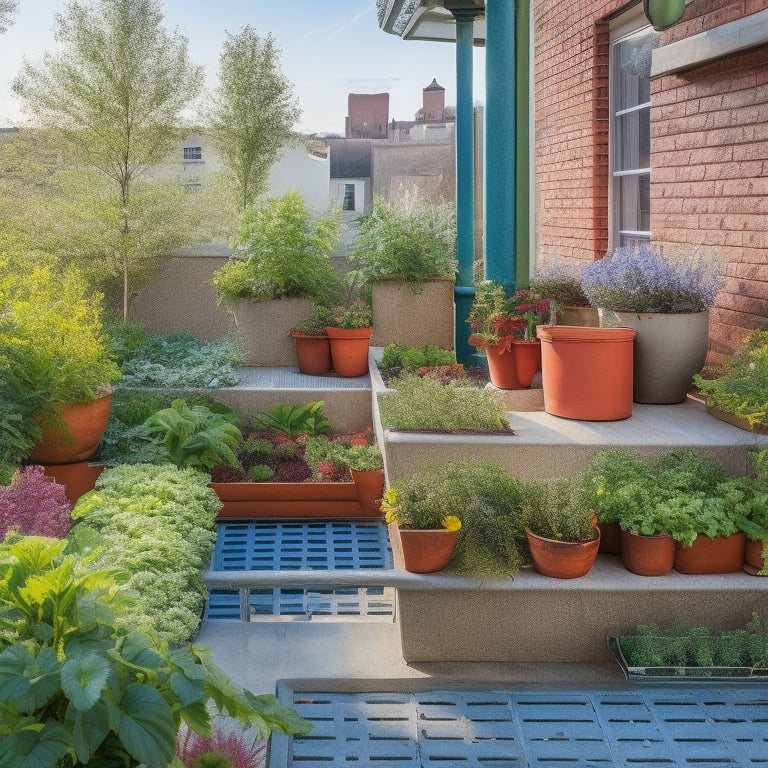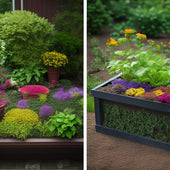
What You Need to Know for Rooftop Veggie Success
Share
You're about to tap into the potential of your rooftop by growing your own veggies, and with the right knowledge, you'll be harvesting fresh produce in no time. Assess your roof's load capacity and choose a flat roof with a concrete or steel deck, ensuring safe access for maintenance and harvesting. Select compact, shade-tolerant veggies like leafy greens and cherry tomatoes, and design your garden bed to support under 20-25 pounds per square foot. Consider drip irrigation and regular soil testing to maintain soil health, and get ready to take your rooftop garden to the next level with expert tips and tricks.
Key Takeaways
• Assess your roof's load capacity and structural integrity to ensure it can support the weight of a rooftop garden.
• Choose compact, shade-tolerant vegetable varieties suitable for container gardening and rooftop conditions.
• Design and build a garden bed with a weight capacity of under 20-25 pounds per square foot, using durable, weather-resistant materials.
• Implement an efficient watering system, such as drip irrigation combined with rainwater harvesting, to conserve resources and reduce waste.
• Regularly test and maintain rooftop soil health through composting, fertilizing, and monitoring pH levels to ensure optimal plant growth.
Choosing the Right Roof Type
When planning your rooftop veggie garden, you'll need to determine whether your rooftop can support the weight of a garden, which depends on the type of roof you have. A roof's load capacity is essential, as you don't want your garden to compromise the structural integrity of your building.
Flat roofs with a concrete or steel deck are ideal for rooftop gardens, as they can support a higher roof load. On the other hand, roofs with asphalt shingles or clay tiles may not be suitable, as they can be damaged by the weight of the garden.
You'll also need to take into account roof access when planning your garden. Make sure that you have a safe and convenient way to transport plants, tools, and other materials to and from the rooftop. A roof with easy access, such as a staircase or elevator, will make maintenance and harvesting a breeze.
Additionally, think about the roof's slope and drainage system to prevent waterlogged soil and erosion. By choosing the right roof type and making sure you have safe roof access, you'll be well on your way to creating a thriving rooftop veggie garden that brings you joy and fresh produce for years to come.
Selecting Vegetables for Rooftop
Selecting the right vegetables for your rooftop garden is essential, as some varieties thrive in containers and intense sunlight, while others require more shade and soil depth.
When choosing veggies for your rooftop, consider those that are compact, produce smaller fruits, and have shorter maturation periods. These traits make them ideal for container gardening and vertical planting.
Leafy greens like lettuce, kale, and spinach are perfect for rooftop gardens, as they're easy to grow and can tolerate partial shade. Cherry tomatoes, cucumbers, and carrots are also great options, as they're compact, produce smaller fruits, and can thrive in containers.
Don't forget about herbs like basil, mint, and cilantro, which add flavor and fragrance to your dishes.
When selecting veggies, be sure to check the seed packet or plant label for specific growing requirements, such as sunlight and watering needs.
Building a Rooftop Garden Bed
You'll need to create a sturdy and well-draining rooftop garden bed that can support the weight of your chosen veggies and withstand exposure to wind, sun, and rain.
When designing your garden bed, take into account the weight limitations of your rooftop. A general rule of thumb is to keep the total weight, including soil, plants, and water, under 20-25 pounds per square foot. You'll also want to make sure your bed is at least 6-8 inches deep to allow for good root growth.
In terms of design considerations, think about the layout and accessibility of your bed. A raised bed with a trellis or wall-mounted planter can be a great space-saving option.
You'll also want to think about the material of your bed, such as wood, metal, or recycled plastic. Make sure it's durable, weather-resistant, and won't leach chemicals into the soil.
Watering and Irrigation Systems
Proper watering and irrigation are essential to the success of your rooftop veggie garden, as they directly impact plant growth and productivity. You'll want to guarantee your plants receive the right amount of water, without wasting this precious resource. One effective way to achieve this is through drip irrigation, which delivers water directly to the roots of your plants, reducing evaporation and runoff.
Consider combining drip irrigation with rainwater harvesting, a sustainable practice that collects and stores rainwater for non-potable uses like watering your garden. This not only reduces your water bill but also decreases the burden on municipal water supplies.
Here's a breakdown of different irrigation systems and their benefits:
| Irrigation System | Water Efficiency | Initial Investment |
|---|---|---|
| Drip Irrigation | High | Moderate |
| Sprinkler System | Medium | Low |
| Rainwater Harvesting | High | High |
Maintaining Rooftop Soil Health
To guarantee a thriving rooftop veggie garden, test your soil regularly to identify nutrient deficiencies and pH imbalances that can hinder plant growth and productivity. Soil testing will help you determine the nutrient levels, pH, and organic matter content of your soil. This information will guide you in making informed decisions about fertilizers, amendments, and composting techniques that will benefit your plants.
As you maintain your rooftop soil health, remember that composting is a key component. By incorporating compost into your soil, you'll increase its water-holding capacity, improve its structure, and provide essential nutrients for your veggies. Consider implementing composting techniques like vermicomposting, bokashi, or traditional composting to turn kitchen scraps and organic waste into nutrient-rich soil amendments.
Regular soil testing will also help you monitor the effectiveness of your composting efforts and make adjustments as needed. By staying on top of your soil's health, you'll be rewarded with a thriving rooftop veggie garden that's teeming with life and productivity.
Frequently Asked Questions
Can I Grow Vegetables on a Rooftop With High Winds?
While high winds might howl on your rooftop, you can still harvest a bounty of veggies - choose wind-resistant plants like kale and broccoli, and design your rooftop garden with sturdy trellises and windbreaks to shield your crops.
Do Rooftop Gardens Attract Unwanted Pests or Rodents?
You'll want to prioritize pest control and rodent prevention in your rooftop garden, as unwanted critters can quickly ruin your harvest; use physical barriers, organic repellents, and clever planting strategies to keep them at bay.
How Do I Handle Rooftop Garden Waste and Composting?
"Your rooftop oasis is thriving, but don't let waste pile up like a storm cloud on the horizon! You'll need to implement smart composting techniques and waste management strategies to keep your garden growing strong and healthy."
Are Rooftop Gardens Safe for Children and Pets to Access?
You guarantee child safety by installing secure railings and gates, while pet considerations involve keeping toxic plants out of reach and providing pet-friendly pathways, creating a safe and enjoyable rooftop garden for all.
Do Rooftop Gardens Increase Property Value or Insurance Rates?
Just like a masterpiece adds value to a art gallery, a well-designed rooftop garden can boost your property's worth, but you'll want to factor in insurance implications during the property appraisal process to avoid any surprises.
Related Posts
-

How Much Do Concrete Planters Weigh
When creating a concrete planter, you'll need to take into account the weight implications of your design. The type a...
-

How Much Do Concrete Planters Weigh
When creating a concrete planter, you'll need to take into account the weight implications of your design. The type a...
-

How Much Do Concrete Planters Weigh
When creating a concrete planter, you'll need to take into account the weight implications of your design. The type a...
-

How Much Do Concrete Planters Weigh
When creating a concrete planter, you'll need to take into account the weight implications of your design. The type a...
-

How Much Do Concrete Planters Weigh
When creating a concrete planter, you'll need to take into account the weight implications of your design. The type a...
-

How Much Do Concrete Planters Weigh
When creating a concrete planter, you'll need to take into account the weight implications of your design. The type a...
-

How Much Do Concrete Planters Weigh
When creating a concrete planter, you'll need to take into account the weight implications of your design. The type a...
-

How Much Do Concrete Planters Weigh
When creating a concrete planter, you'll need to take into account the weight implications of your design. The type a...
-

How Much Do Concrete Planters Weigh
When creating a concrete planter, you'll need to take into account the weight implications of your design. The type a...
-

How Much Do Concrete Planters Weigh
When creating a concrete planter, you'll need to take into account the weight implications of your design. The type a...
-

How Much Do Concrete Planters Weigh
When creating a concrete planter, you'll need to take into account the weight implications of your design. The type a...
-

How Much Do Concrete Planters Weigh
When creating a concrete planter, you'll need to take into account the weight implications of your design. The type a...
-

How Much Do Concrete Planters Weigh
When creating a concrete planter, you'll need to take into account the weight implications of your design. The type a...
-

How Much Do Concrete Planters Weigh
When creating a concrete planter, you'll need to take into account the weight implications of your design. The type a...
-

How Much Do Concrete Planters Weigh
When creating a concrete planter, you'll need to take into account the weight implications of your design. The type a...
-

How Much Do Concrete Planters Weigh
When creating a concrete planter, you'll need to take into account the weight implications of your design. The type a...
-

How Much Do Concrete Planters Weigh
When creating a concrete planter, you'll need to take into account the weight implications of your design. The type a...
-

How Much Do Concrete Planters Weigh
When creating a concrete planter, you'll need to take into account the weight implications of your design. The type a...
-

How Much Do Concrete Planters Weigh
When creating a concrete planter, you'll need to take into account the weight implications of your design. The type a...
-

How Much Do Concrete Planters Weigh
When creating a concrete planter, you'll need to take into account the weight implications of your design. The type a...
-

How Much Do Concrete Planters Weigh
When creating a concrete planter, you'll need to take into account the weight implications of your design. The type a...
-

How Much Do Concrete Planters Weigh
When creating a concrete planter, you'll need to take into account the weight implications of your design. The type a...
-

How Much Do Concrete Planters Weigh
When creating a concrete planter, you'll need to take into account the weight implications of your design. The type a...
-

How Much Do Concrete Planters Weigh
When creating a concrete planter, you'll need to take into account the weight implications of your design. The type a...
-

How Much Do Concrete Planters Weigh
When creating a concrete planter, you'll need to take into account the weight implications of your design. The type a...
-

How Much Do Concrete Planters Weigh
When creating a concrete planter, you'll need to take into account the weight implications of your design. The type a...
-

How Much Do Concrete Planters Weigh
When creating a concrete planter, you'll need to take into account the weight implications of your design. The type a...
-

How Much Do Concrete Planters Weigh
When creating a concrete planter, you'll need to take into account the weight implications of your design. The type a...
-

How Much Do Concrete Planters Weigh
When creating a concrete planter, you'll need to take into account the weight implications of your design. The type a...
-

Soil Selection for Successful Planter Garden Boxes
When selecting soil for your planter garden box, it's important to balance drainage, moisture retention, and nutrient...
-

Soil Selection for Successful Planter Garden Boxes
When selecting soil for your planter garden box, it's important to balance drainage, moisture retention, and nutrient...
-

Soil Selection for Successful Planter Garden Boxes
When selecting soil for your planter garden box, it's important to balance drainage, moisture retention, and nutrient...
-

Soil Selection for Successful Planter Garden Boxes
When selecting soil for your planter garden box, it's important to balance drainage, moisture retention, and nutrient...
-

Soil Selection for Successful Planter Garden Boxes
When selecting soil for your planter garden box, it's important to balance drainage, moisture retention, and nutrient...
-

Soil Selection for Successful Planter Garden Boxes
When selecting soil for your planter garden box, it's important to balance drainage, moisture retention, and nutrient...
-

Soil Selection for Successful Planter Garden Boxes
When selecting soil for your planter garden box, it's important to balance drainage, moisture retention, and nutrient...
-

Soil Selection for Successful Planter Garden Boxes
When selecting soil for your planter garden box, it's important to balance drainage, moisture retention, and nutrient...
-

Soil Selection for Successful Planter Garden Boxes
When selecting soil for your planter garden box, it's important to balance drainage, moisture retention, and nutrient...
-

Soil Selection for Successful Planter Garden Boxes
When selecting soil for your planter garden box, it's important to balance drainage, moisture retention, and nutrient...
-

Soil Selection for Successful Planter Garden Boxes
When selecting soil for your planter garden box, it's important to balance drainage, moisture retention, and nutrient...
-

Soil Selection for Successful Planter Garden Boxes
When selecting soil for your planter garden box, it's important to balance drainage, moisture retention, and nutrient...
-

Soil Selection for Successful Planter Garden Boxes
When selecting soil for your planter garden box, it's important to balance drainage, moisture retention, and nutrient...
-

Soil Selection for Successful Planter Garden Boxes
When selecting soil for your planter garden box, it's important to balance drainage, moisture retention, and nutrient...
-

Soil Selection for Successful Planter Garden Boxes
When selecting soil for your planter garden box, it's important to balance drainage, moisture retention, and nutrient...
-

Soil Selection for Successful Planter Garden Boxes
When selecting soil for your planter garden box, it's important to balance drainage, moisture retention, and nutrient...
-

Soil Selection for Successful Planter Garden Boxes
When selecting soil for your planter garden box, it's important to balance drainage, moisture retention, and nutrient...
-

Soil Selection for Successful Planter Garden Boxes
When selecting soil for your planter garden box, it's important to balance drainage, moisture retention, and nutrient...
-

Soil Selection for Successful Planter Garden Boxes
When selecting soil for your planter garden box, it's important to balance drainage, moisture retention, and nutrient...
-

Soil Selection for Successful Planter Garden Boxes
When selecting soil for your planter garden box, it's important to balance drainage, moisture retention, and nutrient...
-

Soil Selection for Successful Planter Garden Boxes
When selecting soil for your planter garden box, it's important to balance drainage, moisture retention, and nutrient...
-

Soil Selection for Successful Planter Garden Boxes
When selecting soil for your planter garden box, it's important to balance drainage, moisture retention, and nutrient...
-

Soil Selection for Successful Planter Garden Boxes
When selecting soil for your planter garden box, it's important to balance drainage, moisture retention, and nutrient...
-

Soil Selection for Successful Planter Garden Boxes
When selecting soil for your planter garden box, it's important to balance drainage, moisture retention, and nutrient...
-

Soil Selection for Successful Planter Garden Boxes
When selecting soil for your planter garden box, it's important to balance drainage, moisture retention, and nutrient...
-

Soil Selection for Successful Planter Garden Boxes
When selecting soil for your planter garden box, it's important to balance drainage, moisture retention, and nutrient...
-

Soil Selection for Successful Planter Garden Boxes
When selecting soil for your planter garden box, it's important to balance drainage, moisture retention, and nutrient...
-

Soil Selection for Successful Planter Garden Boxes
When selecting soil for your planter garden box, it's important to balance drainage, moisture retention, and nutrient...
-

Soil Selection for Successful Planter Garden Boxes
When selecting soil for your planter garden box, it's important to balance drainage, moisture retention, and nutrient...
-

Soil Selection for Successful Planter Garden Boxes
When selecting soil for your planter garden box, it's important to balance drainage, moisture retention, and nutrient...
-

Soil Selection for Successful Planter Garden Boxes
When selecting soil for your planter garden box, it's important to balance drainage, moisture retention, and nutrient...
-

Soil Selection for Successful Planter Garden Boxes
When selecting soil for your planter garden box, it's important to balance drainage, moisture retention, and nutrient...
-

Inspect and Revive Second-Hand Tools for Planters
When inspecting and reviving second-hand tools for planters, prioritize tools with sturdy builds and functional parts...
-

Inspect and Revive Second-Hand Tools for Planters
When inspecting and reviving second-hand tools for planters, prioritize tools with sturdy builds and functional parts...
-

Inspect and Revive Second-Hand Tools for Planters
When inspecting and reviving second-hand tools for planters, prioritize tools with sturdy builds and functional parts...
-

Inspect and Revive Second-Hand Tools for Planters
When inspecting and reviving second-hand tools for planters, prioritize tools with sturdy builds and functional parts...
-

Inspect and Revive Second-Hand Tools for Planters
When inspecting and reviving second-hand tools for planters, prioritize tools with sturdy builds and functional parts...
-

Inspect and Revive Second-Hand Tools for Planters
When inspecting and reviving second-hand tools for planters, prioritize tools with sturdy builds and functional parts...
-

Inspect and Revive Second-Hand Tools for Planters
When inspecting and reviving second-hand tools for planters, prioritize tools with sturdy builds and functional parts...
-

Inspect and Revive Second-Hand Tools for Planters
When inspecting and reviving second-hand tools for planters, prioritize tools with sturdy builds and functional parts...
-

Inspect and Revive Second-Hand Tools for Planters
When inspecting and reviving second-hand tools for planters, prioritize tools with sturdy builds and functional parts...
-

Inspect and Revive Second-Hand Tools for Planters
When inspecting and reviving second-hand tools for planters, prioritize tools with sturdy builds and functional parts...
-

Inspect and Revive Second-Hand Tools for Planters
When inspecting and reviving second-hand tools for planters, prioritize tools with sturdy builds and functional parts...
-

Inspect and Revive Second-Hand Tools for Planters
When inspecting and reviving second-hand tools for planters, prioritize tools with sturdy builds and functional parts...
-

Inspect and Revive Second-Hand Tools for Planters
When inspecting and reviving second-hand tools for planters, prioritize tools with sturdy builds and functional parts...
-

Inspect and Revive Second-Hand Tools for Planters
When inspecting and reviving second-hand tools for planters, prioritize tools with sturdy builds and functional parts...
-

Inspect and Revive Second-Hand Tools for Planters
When inspecting and reviving second-hand tools for planters, prioritize tools with sturdy builds and functional parts...
-

Inspect and Revive Second-Hand Tools for Planters
When inspecting and reviving second-hand tools for planters, prioritize tools with sturdy builds and functional parts...
-

Inspect and Revive Second-Hand Tools for Planters
When inspecting and reviving second-hand tools for planters, prioritize tools with sturdy builds and functional parts...
-

Inspect and Revive Second-Hand Tools for Planters
When inspecting and reviving second-hand tools for planters, prioritize tools with sturdy builds and functional parts...
-

Inspect and Revive Second-Hand Tools for Planters
When inspecting and reviving second-hand tools for planters, prioritize tools with sturdy builds and functional parts...
-

Inspect and Revive Second-Hand Tools for Planters
When inspecting and reviving second-hand tools for planters, prioritize tools with sturdy builds and functional parts...
-

Inspect and Revive Second-Hand Tools for Planters
When inspecting and reviving second-hand tools for planters, prioritize tools with sturdy builds and functional parts...
-

Inspect and Revive Second-Hand Tools for Planters
When inspecting and reviving second-hand tools for planters, prioritize tools with sturdy builds and functional parts...
-

Inspect and Revive Second-Hand Tools for Planters
When inspecting and reviving second-hand tools for planters, prioritize tools with sturdy builds and functional parts...
-

Inspect and Revive Second-Hand Tools for Planters
When inspecting and reviving second-hand tools for planters, prioritize tools with sturdy builds and functional parts...
-

Inspect and Revive Second-Hand Tools for Planters
When inspecting and reviving second-hand tools for planters, prioritize tools with sturdy builds and functional parts...
-

Inspect and Revive Second-Hand Tools for Planters
When inspecting and reviving second-hand tools for planters, prioritize tools with sturdy builds and functional parts...


